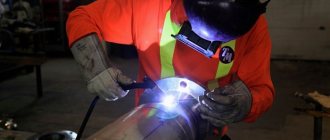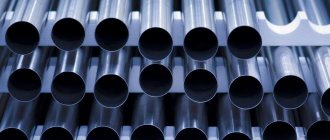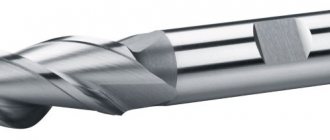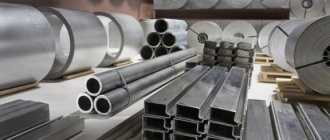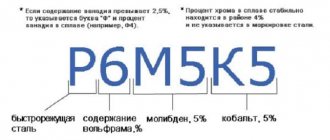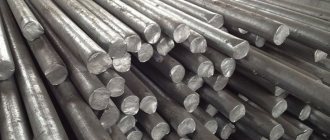04/24/2020 Author: VT-METALL
Issues discussed in the material:
- Physical properties of stainless steel
- How chemical composition affects the properties of stainless steel
- Types of stainless steels and their properties
- Popular grades of stainless steel, properties of these alloys and areas of their application
- How to determine the properties of stainless steel by markings
- About AISI stainless steel marking
- In what areas are the properties of stainless steel applicable?
It’s hard to imagine modern life without anti-corrosion steel. The unique properties of stainless steel are used in many areas: metallurgy, mechanical engineering, chemical and food industries. Stainless steel is resistant to corrosion, which allows it to be used in quite aggressive conditions.
However, the properties of steel are not constant and can vary depending on the amount and type of impurities in it. There are different types and grades of stainless steel, each suitable for a specific industry. To understand what type of products is needed for a particular case, it is worth familiarizing yourself in detail with the characteristics of the material.
Physical properties of stainless steel
A patent for stainless steel was issued in 1913 in Great Britain. Its creator was metallurgist Harry Brearley. The invention gave a huge impetus to the development of steel and other industries.
Stainless steel gained its popularity due to its wide variety of physical properties, including anti-corrosion. New steels are made with the addition of various types of impurities to the main component. The physical properties of stainless steel depend on the type and volume of additives.
We recommend articles on metalworking
- Steel grades: classification and interpretation
- Aluminum grades and areas of their application
- Defects in metal products: causes and search methods
During long-term use, a number of grades of stainless steel can succumb to corrosion. This is influenced by the impurities of various metals included in its composition. However, such alloys also have a number of advantages, due to which the likelihood of oxidation is no longer so serious.
The main physical properties of stainless steel, which distinguish it from some other metals, are:
- Strength. This quality of steel allows us to produce products that compare favorably with analogues. Resistance to physical stress prevents the product from deforming, maintaining its original appearance for a long time. The reliability of high-quality stainless steel lasts up to 10 years.
- Resistance to aggressive environments. External conditions have virtually no effect on the material, which makes it possible to use it for a long time while maintaining all its properties.
- Heat resistance. All products made from this metal are highly resistant to temperature effects, including direct heating by fire. They do not change their size, shape, or properties in the event of large temperature changes.
- Environmental Safety. The anti-corrosion properties of the material prevent it from oxidizing. The metal does not contain components harmful to health, which makes it possible to use it in the food industry.
- Anti-corrosion properties. They are basic for stainless steel and prevent rust from appearing on the metal. Moreover, even alkalis and acids cannot affect the occurrence of corrosion.
- Appearance of products. It is very different from products made from other metals. The surface of the products continues to remain shiny and clean for a long time.
- Compliance. Processing stainless steel is quite simple. It is easy to make a product of the required shape from this metal.
Before choosing a metal with given physical properties, you should determine the purposes for which it is needed. Scientists have developed many different components and impurities that help make a metal with desired characteristics.
How chemical composition affects the properties of stainless steel
How can metal become resistant to corrosion? During production, a number of chemical elements are added to it, as a result the entire surface is covered with an oxide film. It is insoluble and protects the alloy from rust formation.
VT-metall offers services:
Nickel and iron-nickel, as well as alloys based on them, can be used as the main material for the manufacture of stainless steel. Adding alloying elements to the base gives the steel various properties, including stainless steel qualities:
- Chromium increases corrosion resistance and also increases the strength and hardness of the alloy. Reducing the linear expansion coefficient simplifies the welding process.
- Nickel increases ductility and viscosity, as well as hardenability, and it also reduces the coefficient of thermal expansion. This makes it possible to use the products together with various acids: phosphoric, sulfuric, hydrochloric.
- The resistance of the alloy increases due to the use of manganese in an amount of more than 1%. It simultaneously increases hardness, toughness, hardenability, and wear resistance. Some manganese can be replaced with nickel.
- The influence of titanium on the properties of stainless steel is expressed in increasing the density and strength of the alloy, which increases its resistance to corrosion.
- Tungsten reduces brittleness and increases hardness during heat treatment (tempering). This occurs due to the formation of compounds of increased hardness such as carbides.
- Vanadium increases the hardness, strength and density of the alloy.
- Molybdenum imparts anti-corrosion qualities and increases the elasticity of stainless steel, increases the maximum tensile strength (tensile strength), as well as the metal’s resistance to high temperatures.
- Welded structures are protected with niobium, which reduces the likelihood of corrosion.
- Heat resistance, acidity, elasticity and resistance to scale formation are enhanced by silicon. It increases strength and electrical resistance while maintaining the same viscosity level.
- Impact resistance increases due to the addition of cobalt. It also enhances the heat-resistant properties of the material.
- Thanks to copper, the metal will not be affected by atmospheric corrosion.
- By adding aluminum, material aging is reduced and fluidity and toughness are increased.
Thanks to its exceptional characteristics, stainless steel differs from other metals. This makes it possible to use it in such areas of industry and life that require the use of structures, equipment and products at high humidity, as well as under regular influence of an aggressive environment. An example is the use of material for the manufacture of cutlery, as well as knives, fences, various parts of communications, equipment elements, etc.
Decryption procedure
Positions in the notation, from left to right.
- 1st – C (carbon) content, expressed in hundredths of a percent.
- 2nd – chemical element providing alloying.
| Aluminum | Al, Yu | Copper | Cu, M | Vanadium | V, F |
| Chromium | X | Nitrogen | N, A | Tungsten | W, V |
| Niobium | Nb, B | Bor | V, R | Silicon | Si, C |
| Zirconium | Zr, C | Cobalt | Co, K | Tantalum | Ta |
| Selenium | Se, E | Iron | Fe, F | Titanium | Ti, T |
| Nickel | Ni, N | Molybdenum | Mo, M | Manganese | Mn, G |
3rd – percentage of alloying additive in steel. If it is equal to or less than 1, then the number is not entered.
Examples of marking of high-alloy steels
8Х18Н10Т – carbon (0.08), chromium (18), nickel (10), titanium (1).
38Х12МУА – carbon (0.38); chromium (12); molybdenum and aluminum - 1% each. The last letter (A) indicates the high quality of the steel.
As already noted, the division of high-alloy steels into groups (austenitic, martensitic, and so on), the specifics of application (tool, structural) are described in GOST and do not directly relate to the topic of the article. And the author has already explained in detail how to “read” the markings correctly.
What properties do alloying elements impart to steel?
Many of the additives are similar in their effect on the material. For example, they increase its strength and corrosion resistance. Therefore, we note only those characteristics of steel on which a specific additive has the maximum impact. That is, it significantly improves them.
- Titanium – heat resistance; also promotes compaction of the structure by removing excess nitrogen.
- Cobalt – mechanical strength.
- Vanadium, tungsten, molybdenum - prevent grain growth and contribute to the invariability of the structure of high-alloy steel. Its cutting ability increases. In addition, Mo has a positive effect on the heat resistance of the material.
- Nickel – increases elasticity and rust resistance.
- Chromium – imparts many properties. In addition to those listed above, it ensures that steel is not susceptible to abrasion and its high-quality calcination.
- Manganese – hardness. However, as the temperature increases, the grain increases in size. This has a negative impact on impact strength.
- Silicon – gives steel elasticity.
One of the features of processing high-alloy steels is their hardening technology. It is produced not in water, but in oil.
Types of stainless steels and their properties
The unique characteristics of stainless steel are manifested due to the chemical composition and structure of the materials.
Steels included in the stainless steel group are divided into four groups depending on the specified parameters:
1. Chromium or ferritic.
This group of steels got its name due to its 20% chromium content. It greatly increases the resistance of the metal to aggressive environments. The ferromagnetic properties of stainless steel in this group are quite high.
Chromium steels are used in industrial enterprises related to the chemical and heavy industries. For example, heating devices and their parts are made from them. This group of stainless steels is in great demand on the market, second only to the category that has an austenitic structure. However, their cost is significantly lower.
2. Austenitic steels.
The chemical composition of stainless steels of this group contains no more than 33% nickel and chromium. Buyers value this material for its significant strength and almost absolute resistance to corrosion.
Steels belonging to the austenitic group are divided into the following types:
- A1 – this material contains a significant amount of sulfur, which reduces its anti-corrosion resistance, unlike other steels.
- A2 is the most popular brand. This material is excellent for welding without losing the thermophysical properties of stainless steel. It is resistant to subzero temperatures, but an acidic, aggressive environment can break its anti-corrosion protection.
- A3 is grade A2 with the addition of various stabilizing components. Resistant to both acidic environments and elevated temperatures.
- A4 – no more than 3% molybdenum is added to this alloy. Its effect on the properties of stainless steel is to increase its resistance to acidic environments. This brand is widely used in the construction of ships.
- A5 is similar to brand A4, differing only in the amount of stabilizing additives. It is made to increase resistance to elevated temperatures.
3. Ferritic-martensitic and martensitic.
The special structure of such alloys gives them extremely high strength - the best of all steels. In addition to the above, they contain a minimum of harmful impurities and are characterized by excellent wear resistance. This category includes heat-resistant, corrosion-resistant steel. It actively resists oxidation processes and can be constantly used at high ambient temperatures, maintaining the original composition and properties of stainless steel.
4. Combined.
The structure of steels in this group is of a combined type: austenitic-martensitic and austenitic-ferritic. The innovative materials of this group combine all the best properties of stainless steel described earlier, including magnetic ones.
The types of steels listed above are not all types of stainless steels. The reason is that even a slight change in the ratio of alloy components can greatly change the properties of stainless steel. Information about whether an alloy grade belongs to a particular group makes it possible to optimally select a material that will help in solving the assigned technological problems.
We supply products from the following steels from our warehouse:
| Steel group | Material number | Short designation | AISI number |
| Austenitic structure | |||
| A1 | 1.4305 | X 10 CrNiS 18-9 | AISI 303 |
| A2 | 1.4301 1.4303 | X 5 CrNi 18-10 X 4 CrNi 18-12 | AISI 304 AISI 305 |
| A3 | 1.4541 | X 6 CrNiTi 18-10 | AISI 321 |
| A4 | 1.4401 1.4404 | X 5 CrNiMo 18-10 X 2 CrNiMo 18-10 | AISI 316 AISI 316 L |
| A5 | 1.4571 | X 6 CrNiMoTi 17-12-2 | AISI 316 TI |
The designation “V2A” dates back to 1912 and signifies the result of “Versuchsreihe 2 Austenit” (“Experimental Series 2 Austenit”). Then “V3A”, “V4A”, etc. also appeared, and although these concepts are used today mainly in the form of abbreviations “A2”, “A3”, “A4”, etc., these designations are not unambiguous. Today there is a pan-European numbering system. It should be noted that there is no one-to-one correspondence between the designations according to AISI or UNS and the numbering of materials according to EN 10088. For example, the material AISI 304L is related to the material 1.4306, although it has the same properties as 1.4301 and 1.4541.
Popular grades of stainless steel, properties of these alloys and areas of their application
To select the stainless steel required for the production of products for a specific purpose, specialists use special reference books. They list the grades, properties of stainless steel and its characteristics. In each group of materials there are types that are gaining popularity, and consumers choose them most often.
Let's look at some:
- 20Х13, 12Х13, 08Х13 – used for the production of cutlery, dishes and products subject to shock loads. They withstand exposure to aggressive environments at normal temperatures. Polishing and heat treatment improve the performance and fundamental properties of stainless steel.
- 08Х18Т1 and 12Х17 – are used for the manufacture of kitchen appliances and for the production of equipment that is used in the food industry. It is considered rational to use these products after annealing.
- 40Х13 and 30Х13 – this is how medical stainless steel used in the production of surgical instruments is marked.
- 40Х9С2 – steel grade resistant to high temperatures. It is used for the production of heat exchangers and engines running on diesel fuel. In internal combustion engines, exhaust manifold valves are made from this material.
- 15X25T is a heat-resistant grade of stainless steel that is used in pyrolysis equipment operating at high temperatures.
- 12Х18Н9Т – this brand is used to produce pipes, fittings for furnaces, as well as housings for spark plugs. The mechanical properties of stainless steel 12Х18Н10Т allow its use for the production of high-pressure pipes.
- 40Х9С2 – this steel is used in the production of valves for engines and is heat resistant.
- 14Х17Н2 – intended for equipment operating at ultra-high temperatures (up to +800 °C).
- 10Х23Н18 – steel for the manufacture of products intended for operation at temperatures not exceeding +1,000 °C, as well as at low loads.
Application
Alloyed stainless steels and alloys are used in the most extreme conditions: for the production of chemical equipment, turbine blades for space engine jet engines and nuclear boilers. In instrument making, the ferromagnetic properties of iron are important, and in electrical engineering, the high resistance of nickel alloys is important.
Provider
Alloyed stainless steels and alloys from the supplier "Auremo" comply with GOST and international quality standards. The supplier "Auremo" offers to buy alloy steel on favorable terms, the price is optimal. We offer to buy stainless steel products from specialized warehouses of the supplier “Auremo” with delivery to any city. For wholesale customers the price is preferential. Alloy steel is always available, the price is optimal from the supplier. We are waiting for your orders.
How to determine the properties of stainless steel by markings
Regulatory documents establish the rules by which stainless steel is marked:
- The first number of the name indicates the amount of carbon in the alloy. Example: in steel type 20Х13 – the quantitative indicator of carbon is 0.2%, and in alloy grade 08Х18Т1 – 0.08% carbon.
- The letter represents a chemical element. For example, “M” indicates the presence of manganese, “X” indicates chromium, and “H” indicates nickel. After the letters there are numbers indicating the content of the element in the alloy as a percentage.
Basically, the rules for marking stainless steel do not differ from the generally accepted designations of other types of steel alloys.
New standards for fasteners
Currently and in the coming years, a large number of standards will be revised and declared mandatory. The transition to DIN ISO and DIN EN will continue. Suppliers and consumers should monitor this development with understanding and agree on the timing of the transition. In the middle there was a change in the wrench size of hex bolts and hex nuts (four size ranges).
For hex nuts, the wrench size and, in addition, the height of the nuts change at the same time (type 1 - ISO 4032). The new edition and unification of pins and pins should be noted (for example, EN ISO 2338 instead of DIN 7, pins according to EN ISO 2341 instead of DIN 1434, 1435, 1436). For slotted and Phillips screws, new EN ISO standards were also adopted in October 1994, allowing for dimensional changes. Please note that the basic provisions of DIN 267, parts 1, 4, 5, 9, 11, 12, 18, 19, 20, 21 have been replaced by DIN EN ISO. It was fundamentally established that in the future ENs will no longer have five-digit numeric designations, but the EN ISO designation will indicate that the ISO standard has been accepted as an EN standard and is mandatory. The dual designation will be maintained for a long time, so that products according to EN ISO will be available.
AISI stainless steel marking
The AISI mark is placed not only on products coming from the USA. Today, such a mark is already placed on Russian, Chinese or European. AISI is a classification system that was first adopted in the United States, as reflected in its name: A - American (American), I - Iron (cast iron), S - Steel (steel), I - Institute (institute). This classifier is loved by manufacturers, product buyers and traders.
Alloy and carbon steel are marked with a four-digit code. In it, the first digit is the main alloying element, the second is the secondary alloying component, the third and fourth indicate the presence of carbon in the alloy.
- 1ZZZ – carbon (C);
- 2ZZZ – nickel (Ni);
- 3ZZZ – chromium-nickel alloy (Cr+Ni);
- 4ZZZ – molybdenum (Mo);
- 5ZZZ – chromium (Cr);
- 6ZZZ – chromium alloy with vanadium (Cr+V);
- 7ZZZ – tungsten (W);
- 8ZZZ – alloy of nickel, chromium, molybdenum (Ni+Cr+Mo);
- 9ZZZ – manganese silicide (Si+Mn)
A reduced amount of carbon in the alloy is indicated by the letter “L” located at the end. If “L” appears in the middle of the marking, then it means alloying with lead, which is done in order to improve the mechanical properties of the stainless steel being processed. The “N” at the end indicates nitrogen treatment. This is done in order to increase, under other equal conditions, the tensile strength. The "B" in the middle denotes boron alloying of the alloy.
Alloy steel grades
Alloy steel grades vary. They are presented in a wide variety. Depending on the purpose of the steel, its marking is determined.
Today there are a large number of requirements for marking alloy steel. Numerical and alphabetic notations are used for this process. First, numbers are used for marking. They are indicators of how many hundredths of carbon are contained in a particular type of alloy steel. After the numbers there are letters, which indicate which alloying additives were used in the production of a particular type of alloy steel.
The letters may be followed by numbers indicating the amount of alloying substance in the steel material. If there is no digital designation after the designation of any alloying element, then it contains a minimum amount of it, not reaching even one percent.
Table 1. Comparison of steel grades of type Cm and Fe according to international standards ISO 630-80 and ISO 1052-82.
Steel grades
| St | Fe | St | Fe |
| One hundred | Fe310-0 | St4kp | Fe430-A |
| St1kp | St4ps | Fe430-B | |
| St1ps | St4sp | Fe430-C | |
| St1sp | — | — | Fe430-D |
| St2kp | St5ps | Fe510-B, Fe490 | |
| St2ps | St5Gps | Fe510-B, Fe490 | |
| St2sp | Sg5sp | Fe510-C, Fe490 | |
| StZkp | Fe360-A | ||
| StZps | Fe360-B | St6ps | Fe590 |
| StZGps | Fe360-B | Stbsp | Fe590 |
| StZsp | Fe360-C | Fe690 | |
| StZGsp | Fe360-C | — | |
| Fe360-D |
Table 2. Symbols of alloying elements in metals and alloys
| Element | Symbol | Designation of elements in grades of metals and alloys | Element | Symbol | Designation of elements in grades of metals and alloys | ||
| black | colored | black | colored | ||||
| Nitrogen | N | A | — | Neodymium | Nd | — | Nm |
| Aluminum | A1 | YU | A | Nickel | Ni | — | N |
| Barium | Va | — | Br | Niobium | Nb | B | Np |
| Beryllium | Be | L | Tin | Sn | — | ABOUT | |
| Bor | IN | R | — | Osmium | Os | — | OS |
| Vanadia | V | f | To you | Palladium | Pd | — | front |
| bismuth | Bi | In and | In and | Platinum | Pt | — | Pl |
| Tungsten | W | IN | — | Praseodymium | Pr | — | Etc |
| Gadolinium | Gd | — | Gn | Rhenium | Re | — | Re |
| Gallium | Ga | Gi | Gi | Rhodium | Rh | — | Rg |
| Hafnia | Hf | — | Gf | Mercury | Hg | — | R |
| Germanium | Ge | — | G | Ruthenium | Ru | — | Pv |
| Holmium | But | — | GOM | Samarium | Sm | — | Myself |
| Dysprosium | Dv | — | DIM | Lead | Pb | — | WITH |
| Europium | Eu | — | Ev | Selenium | Se | TO | ST |
| Iron | Fe | — | AND | Silver | Ag | — | Wed |
| Gold | Au | — | Evil | Scandium | Sc | — | From km |
| Indium | In | — | In | Antimony | Sb | — | Cv |
| Iridium | Ir | — | AND | Thallium | Tl | — | Tl |
| Ytterbium | Yb | — | ITN | Tantalum | Ta | — | TT |
| Yttrium | Y | — | THEM | Tellurium | Those | — | T |
| Cadmium | Cd | CD | CD | Terbium | Tb | — | Volume |
| Cobalt | Co | TO | TO | Titanium | Ti | T | TPD |
| Silicon | Si | WITH | Kr(K) | T\'liy | Tm | — | TUM |
| Lanthanum | La | — | La | Carbon | WITH | U | — |
| Lithium | Li | — | Le | Phosphorus | P | P | F |
| Lutetium | Lu | — | Leung | Chromium | Cr | X | X(Xp) |
| Magnesium | Mg | Sh | Mg | Cerium | Ce | — | Xie |
| Manganese | Mn | G | Mts(Mr) | Zinc | Zn | — | C |
| Copper | Cu | D | M | Zirconium | Zr | C | TsEV |
| Molybdenum | Mo | M | — | Erbium | Er | — | Erm |
In what areas are the properties of stainless steel applicable?
Since their appearance, steels with a high level of corrosion resistance have been used exclusively in high-tech industrial production: nuclear energy, mechanical and aircraft construction, and the petrochemical industry. However, in our time, stainless steels have begun to be used in a variety of areas of life.
Here are the main areas of use of stainless steel:
- Mechanical engineering. The mechanical properties of stainless steel are actively used in the manufacture of machines and equipment for industrial enterprises, as well as in the automotive industry. In this case, austenitic and ferritic types are most often used.
- Chemical industry. This area of production involves the use of aggressive substances, the storage of which requires containers and specially designed equipment. Austenitic alloys are used for their manufacture. At the same time, pipes, equipment and vessels are not exposed to chemicals, and therefore maintain their performance characteristics.
- Energy. In this industry, only materials with high strength are used, since the reliability of all working units is especially important.
- Pulp and paper industry. Equipment for this industry is almost entirely made of stainless steel.
- Food industry. Today, high demands are placed on the production process, transportation and storage of products. For the manufacture of equipment, only stainless steel, glass and a number of types of plastic can be used, which provide a high level of hygiene.
The food industry, as a rule, requires the use of alloys that do not contain many components, since the devices are not exposed to either high temperatures or aggressive environments and substances. In the production of refrigeration units, materials with increased frost resistance are used.
- Aviation and space fields. Here, special types of stainless steel are used to produce rockets, airplanes and spacecraft.
- Construction. In this area, steel has found application in design. Stainless steel sheets do not scratch and fingerprints do not remain on them.
Stainless steel is very popular due to its special properties, which determine its areas of application. Simple carbon steels do not have such unique characteristics. Modern industry produces a large number of grades of stainless steel. This makes it possible to select the necessary steel that will “fit” into the process and help successfully solve the problem.



